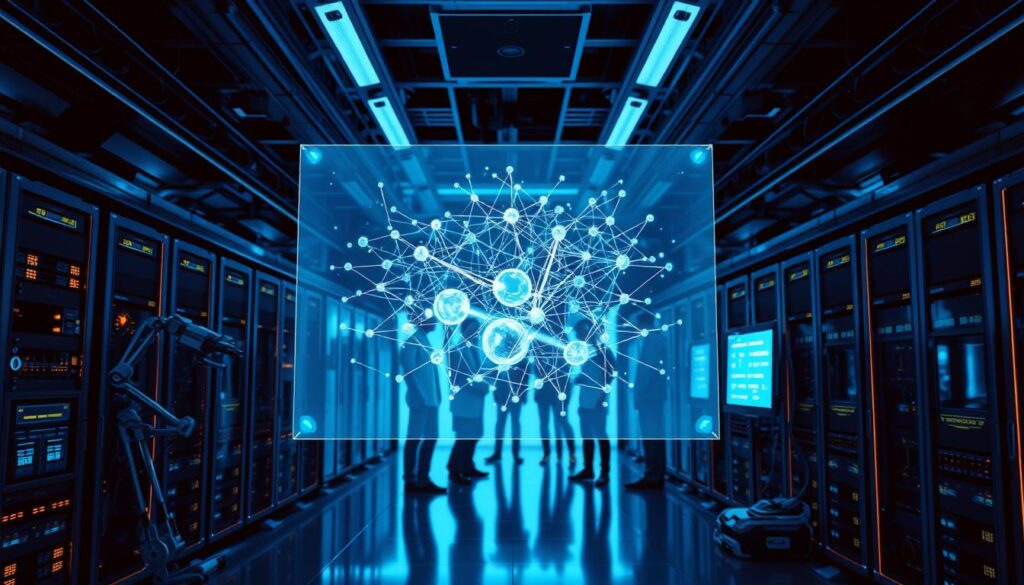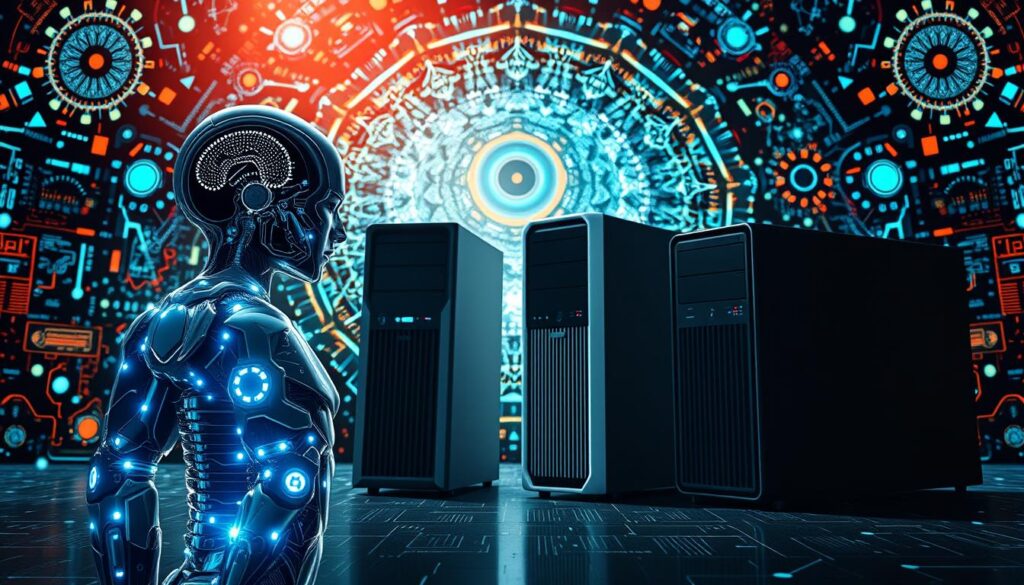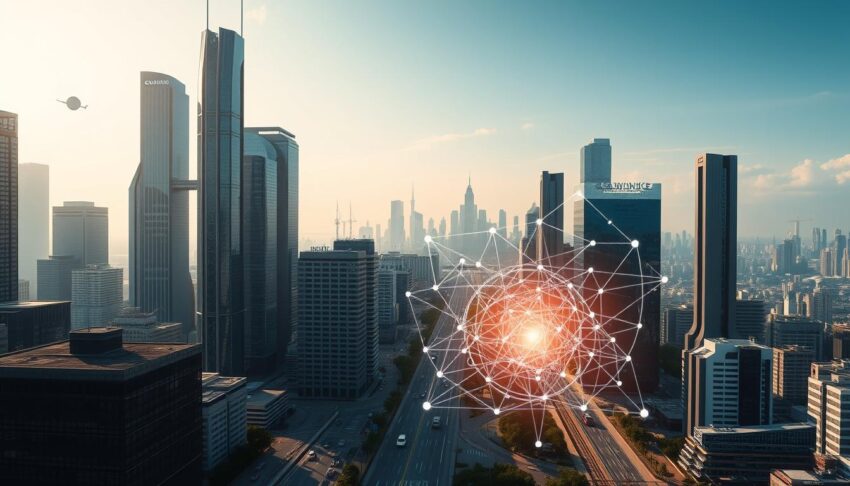Imagine if machines could understand and act like humans. Cognitive computing is changing tech by mixing smart algorithms with human thinking. It uses artificial intelligence to make systems that learn and grow.
This new tech helps us make better choices and work more efficiently. Let's see how it works and how it's changing the world.
Key Takeaways
- Cognitive computing imitates human thought processes for smarter decision-making.
- Artificial intelligence plays a critical role in enhancing cognitive systems.
- Smart technology enhances operational efficiency in various sectors.
- Intelligent automation is changing how businesses leverage data.
- The evolution of AI significantly impacts the advancement of cognitive computing.
Understanding Cognitive Computing
Cognitive computing is where tech meets human thinking. It makes systems think like us in tough situations. It's not just about AI, but also about understanding big data and learning from it.
This tech is great at handling lots of data that's not organized. It makes systems talk to users in smarter ways.
Definition and Overview
Cognitive computing systems think like us to make better choices. Companies like IBM are leading the way with Watson. Watson can understand text, images, and patterns.
This tech is used in many areas like health, money, and helping customers.
Key Components of Cognitive Computing
The parts of cognitive computing help it work like our brains. Key parts are:
- Natural Language Processing (NLP): Lets systems get what we say, making talking easier.
- Machine Learning (ML): Helps systems get better with time by learning from data.
- Reasoning: Allows systems to make choices based on what they've learned before.
- Perception: Lets machines see and hear, making interactions more real.
The Role of Artificial Intelligence in Cognitive Computing
Artificial intelligence makes cognitive systems better and faster. AI technologies help these systems learn and get smarter over time. We will look at the main AI technologies and how they are used in different fields.
AI Technologies That Drive Cognitive Systems
Many AI technologies help cognitive computing work well. These include:
- Machine Learning: Systems learn from data without being told how.
- Natural Language Processing (NLP): Systems understand and work with human language.
- Neural Networks: Models that act like the brain, making hard tasks easier.
Examples of AI in Action
AI in cognitive computing is used in many ways. For example:
| Application | Technology Used | Industry | Impact |
|---|---|---|---|
| IBM Watson | Machine Learning, NLP | Healthcare | Helps doctors analyze patient data for treatment recommendations |
| Chatbots | NLP | Customer Service | Enhances customer interactions through intelligent response systems |
| Self-Driving Cars | Neural Networks | Automotive | Improves safety and efficiency in transportation |

Machine Learning: The Backbone of Cognitive Computing
Machine learning is key for cognitive computing. It helps systems get better with data insights. They learn from big datasets to spot patterns and predict things.
These systems keep getting smarter. They learn from new info as it comes.
How Machine Learning Works
Machine learning trains algorithms on lots of data. This way, systems learn without being told what to do. They find complex patterns and make smart choices.
As they get more info, they get better. This makes them super useful in many areas.
Applications of Machine Learning in Cognitive Systems
Cognitive systems use machine learning in many ways. This changes how businesses work and talk to customers. Some main areas include:
- Predictive Analytics: Helps guess what customers might do next based on what they've done before.
- Anomaly Detection: Important in keeping computers safe by spotting odd activities.
- Personalized Recommendations: Places like Netflix use it to suggest things you might like.
Machine learning is very important. It helps make new ideas and makes things more efficient in many fields.
Cognitive Computing vs. Traditional Computing
Technology has changed a lot with cognitive computing. It's different from old ways of computing. This change helps us make better decisions today.
Old systems use set rules and structured data. But, cognitive computing works with unstructured data. It gets better with experience.
Differences in Processing Information
Cognitive computing and traditional computing are very different. Old systems use fixed rules for data. But, cognitive computing can handle unstructured data better.
This makes it more flexible. It can understand complex data from the real world.
The Shift in Decision-Making Processes
Decision-making has changed with cognitive computing. It helps us make smarter choices from big data. This is good for finance and healthcare.
It makes businesses more ready to adapt. Systems can spot trends and patterns. This helps in making better decisions.

Autonomous Systems and Cognitive Computing
Autonomous systems are changing many industries. They can work alone in complex places. They get better with time thanks to cognitive computing.
Examples include self-driving cars, drones, and robots. This section talks about how these work and their big impact.
Understanding Autonomous Technology
Autonomous systems use smart algorithms to make decisions fast. This makes them work better and do tasks on their own. Companies like Waymo and Tesla use cognitive computing.
They make cars that can drive, see around them, and change with traffic. This makes travel safer and faster.
Impact on Various Industries
Cognitive computing changes more than just cars. It affects many areas:
- Manufacturing: Robots with cognitive systems make things better and faster.
- Aerospace: Drones help with moving things, watching places, and checking the environment.
- Healthcare: Autonomous systems help patients by doing surgeries and watching over them from afar.
This change means more automation and better work. It's all thanks to cognitive computing in autonomous technology.
| Industry | Application of Autonomous Systems | Benefits |
|---|---|---|
| Transportation | Self-driving vehicles | Reduced accidents and improved traffic flow |
| Manufacturing | Cognitive robots in assembly | Increased productivity and lowered costs |
| Aerospace | Delivery drones | Faster logistics and efficiency |
| Healthcare | Robotic surgery systems | Precision and reduced recovery times |
The Impact of Robotics on Cognitive Computing
Robotics and cognitive computing are changing many fields. They let machines do things that need hands-on work. As robots get better, they help make work easier and faster.
Integration of Robotics in Cognitive Systems
Robotics help machines talk to their world better. In hospitals, robots help doctors do surgery with more care. On farms, robots pick the right fruits, making more food.
Stores use robots to sort things out. This makes getting what you need faster.
Future Trends in Robotics and AI
Soon, robots will work with people, not just by themselves. These robots learn from us and get better. They will do harder tasks on their own.
This will make work more efficient. It will make our jobs smarter and easier.
| Industry | Robotics Application | Cognitive Function |
|---|---|---|
| Healthcare | Surgical Robots | Enhanced precision and decision-making |
| Agriculture | Automated Harvesters | Smart crop identification and yield optimization |
| Logistics | Automated Warehouses | Efficient inventory sorting and management |
| Manufacturing | Collaborative Robots (Cobots) | Real-time learning from human operators |
Computer Vision and Cognitive Computing
Computer vision is key in cognitive computing. It lets systems understand images like we do. It uses tech like image recognition and deep learning.
This tech is used in many fields. It makes things work better and makes things easier for us.
How Computer Vision Works
Computer vision works like our eyes. It looks at pictures and videos. It breaks them down into data we can understand.
It uses things like feature extraction and pattern recognition. This lets computers see and understand what they see. Algorithms help find objects in pictures.
Use Cases of Computer Vision in Cognitive Systems
Computer vision is used in many ways. Here are some examples:
- Facial Recognition: Helps with security and knowing who's who.
- Quality Control: Finds problems in products by looking at them.
- Autonomous Vehicles: Helps cars see and move safely.
- Retail Analytics: Helps stores know how to make shopping better.
- Healthcare: Helps doctors see what's wrong in pictures.
Big companies like Google and Amazon use it. They make things better and come up with new ideas.
Automation in Cognitive Computing
Organizations are finding new ways to grow and work better with automation in cognitive computing. Automated systems make data work faster. This means quicker decisions and better analytics.
This change helps cut costs and makes things more accurate. It shows how good automation can be.
Benefits of Automation
Automation in cognitive computing brings big wins. It makes businesses work more efficiently. Automated tasks free up time for important work.
Companies can now focus on big plans instead of small tasks. Automation also makes data more reliable. This helps businesses make smart choices quickly.
Challenges in Implementing Automation
But, starting automation is not easy. There are worries about jobs changing. Also, it takes a lot of money to set it up.
It's hard to make new systems work with old ones. This can cause problems if not done right. So, companies must face these challenges to stay ahead.
